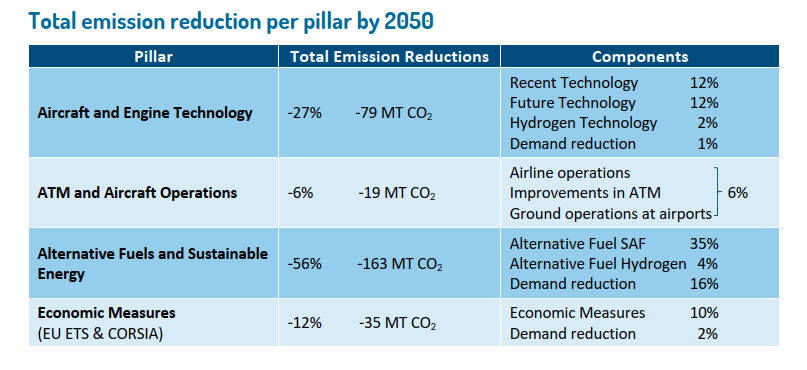Destination 2050: Europe's Roadmap to Net-Zero Aviation Emissions
Europe is aiming for a climate-neutral future by reducing CO2 emissions and fulfilling the climate objectives of the Paris climate agreement. How are aviation and airports contributing to this objective? The answer lies in “Destination 2050”.
What is “Destination 2050”?
Destination 2050 is an initiative and roadmap, which outlines a pathway for achieving net-zero aviation emissions for the EU+ region by 2050. Key partners are
Airlines for Europe (A4E)
Airports Council International Europe (ACI EUROPE)
AeroSpace and Defence Industries Association of Europe (ASD)
Civil Air Navigation Services Organisation (CANSO) and
European Regional Airlines Association (ERA).
The Destination 2050 partners call for the implementation of their roadmap goals at the European level, e.g. in the Clean Industrial Act. The following key measures are defined:
Aircraft and Engine Technologies: Improvements in these areas are expected to reduce emissions by 27%.
Sustainable Aviation fuels (SAF): Scaling up the use of SAF and alternative fuels could achieve a 56% reduction in emissions.
Economic measures: Implementing economic measures like the EU Emissions Trading System (ETS) will contribute to a 12% reduction.
Air Traffic Management and Operations: Enhancements in these areas are projected to reduce emissions by 6%.

Why is Destination 2050 important for airports?
Airports play a crucial role in achieving net-zero emissions in aviation as they will provide ground infrastructure to accommodate future low-emission aircraft technologies and overcome existing barriers and limitations for implementation thereof.
When it comes to economic measures incentives are a possible action to be taken by airports. To accelerate the transition to climate-friendly aviation airports can demand lower or no fees for hydrogen- and electric-powered aircraft in the transition phase or reserve slots for low-emission aircraft. Incentives can also be implemented for encouraging the use of sustainable aviation fuels (SAFs). While this increases the willingness of airlines to use alternative fuels and engine technologies, Destination 2050 leaves open the question of what financial benefit the airport can derive from it.
To be able to supply alternative fuels, mainly hydrogen and SAF, airports need suitable infrastructure. Both the production of hydrogen and SAF and their transportation routes to the airport, as well as storage options on site and routes from the storage facility to the aircraft must be considered. The planning of the infrastructure must be done airport-specific and depends on local conditions and the estimated daily demand for hydrogen and SAF.
Specific measures to reduce emissions from airports regarding ground operations include electrifying the airport’s ground vehicle fleet, offering operational towing with an electric vehicle (e.g. TaxiBot) as sustainable taxi solution and providing external ground power and pre-conditioned air (PCA) to lower the use of APU. Ground power units (GPUs) should therefore be powered by green hydrogen or batteries. The supply of electricity for aircraft at the gate (from 2025) and remote stands (from 2030) is also required by the Regulation for the Deployment of Alternative Fuels Infrastructure (AFIR-Regulation 2023/1804) to reduce emissions of aircraft on ground.
To maximize the environmental benefits the electricity used should come from the grid or should be generated on site without fossil resources. Therefore, generating green energy on site by using solar, wind, biomass, geothermal or hydro power can significantly improve the airport's carbon footprint within scope 1 and 2 according to greenhouse gas (GHG) protocol.
How airsight supports airports in sustainability
Achieving sustainability goals requires airport-specific aeronautical assessments and strategic planning. airsight provides expert guidance to airports in the following key areas:
Renewable Energy at Airports: To power all airport operations with renewable energy and climate-friendly fuels, airsight supports airports in the planning of on-site power plants, including solar farms, wind energy, and other energy sources. To successfully implement PV in an airport setting, airsight applies a five-step approach, ensuring seamless integration with airport operations.
Climate Action: Assessing airport resilience to extreme weather, decarbonization strategies, and the integration of alternative fuels like hydrogen and SAF. To start the decarbonization process, airsight offers a feasibility study tailored to each airport’s specific needs.
Aircraft & Airport Noise and Emissions: Improving fuel efficiency and reducing emissions in ground operations and terminal airspace.
As part of its sustainability efforts, airsight has conducted feasibility studies for airport decarbonization and assessed eco-efficient flight procedures, such as those implemented at Leipzig/Halle Airport.
For airports looking to enhance their sustainability strategies, airsight offers comprehensive expertise to support the transition to climate-friendly aviation. Contact us today to explore tailored solutions for your airport’s sustainability goals.
Image and Information Source: Roadmap - Destination 2050
Key Facts



